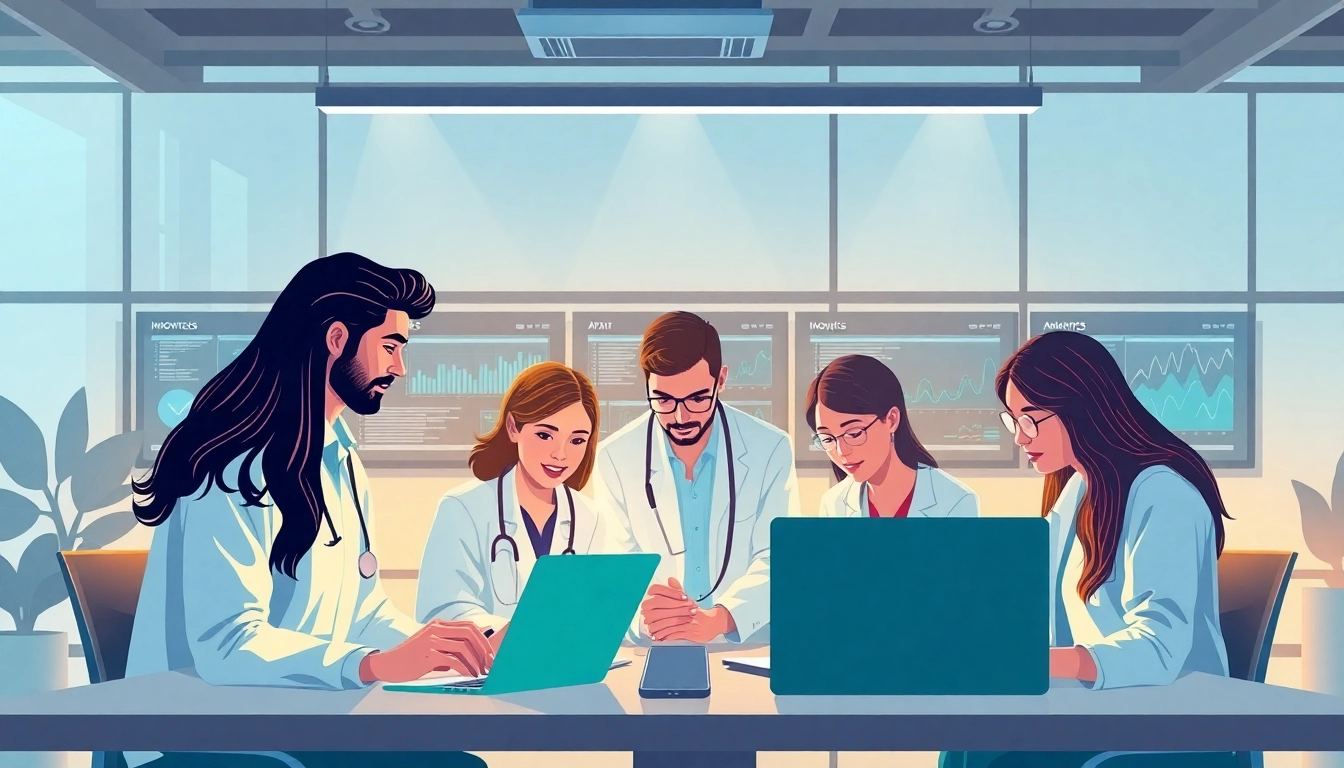Introduction to Healthcare Informatics
In the ever-evolving landscape of healthcare, the integration of technology and data management has revolutionized the way patient care is delivered. This fusion is embodied in the field of healthcare informatics, which combines the principles of information science, computer science, and social science to enhance the efficiency and effectiveness of health care services. As practitioners, health organizations, and systems strive to improve patient outcomes, the emphasis on informatics becomes paramount, making platforms such as www.informaticsview.com essential for accessing relevant resources and strategies. This article will explore the multi-faceted realm of healthcare informatics, focusing on its components, challenges, best practices, and future directions.
Understanding Informatics in Healthcare
Healthcare informatics can be defined as the systematic study of how technology can be used to improve health care delivery and patient outcomes. It encompasses a wide range of applications from electronic health records (EHRs) to telehealth services. By leveraging data and information technology, healthcare informatics seeks to create a seamless flow of information between providers, patients, and systems, ultimately leading to informed decision-making and enhanced care quality.
The Role of Technology in Patient Care
Technology plays a transformative role in patient care. Electronic Health Records (EHRs) are one of the foremost tools in this landscape, allowing clinicians to access patient information quickly and efficiently. These systems not only store clinical data but also enable the sharing of information among different healthcare providers, which is crucial for coordinated care. Moreover, technologies such as Clinical Decision Support Systems (CDSS) provide real-time guidance to clinicians, assisting them in making evidence-based decisions that improve patient safety and outcomes.
Importance of Data in Modern Healthcare
Data is the cornerstone of healthcare informatics. Sophisticated analytics allow practitioners to sift through vast amounts of information, turning it into actionable insights. From understanding population health trends to individual patient monitoring, data can inform strategies that enhance overall health outcomes. Furthermore, data collection and analysis empower healthcare organizations to identify gaps in care, optimize resource allocation, and improve healthcare delivery systems.
Key Components of Informatics Systems
Electronic Health Records (EHRs)
Electronic Health Records are digital versions of patients’ paper charts and are the foundation of health informatics systems. EHRs have transformed how health information is managed, enabling providers to maintain comprehensive and up-to-date records. Key features include:
- Accessibility: EHRs can be accessed by authorized medical personnel anywhere, ensuring that care is informed and timely.
- Interoperability: These systems can share information with other EHR systems, enhancing collaborative care among providers.
- Patient Engagement: Patients can access their health information through patient portals, empowering them to take an active role in their care.
However, transitioning to EHR systems poses challenges that must be addressed to maximize their potential. These include workflow disruptions and the need for medical staff training.
Clinical Decision Support Systems (CDSS)
Clinical Decision Support Systems are computer-based tools that provide healthcare professionals with clinical information and patient-related data to enhance decision-making. CDSS helps in:
- Identifying patient-specific issues using alerts and reminders.
- Supporting clinical guidelines and recommendations based on best practices.
- Enhancing diagnostic accuracy and treatment protocols.
Evidence shows that effective implementation of CDSS leads to better adherence to clinical guidelines, improved patient outcomes, and reduced errors in clinical settings.
Telemedicine and Remote Monitoring
Telemedicine enables healthcare providers to deliver care remotely, breaking geographical barriers and improving access to health services. Remote monitoring devices, such as wearables and home diagnostic kits, have facilitated continuous patient monitoring outside traditional healthcare settings. This advance has led to several benefits:
- Improved Access: Patients in remote areas can have consultations with specialists via videoconferencing.
- Preventive Care: Continuous monitoring can lead to timely interventions before conditions escalate.
- Cost-Effectiveness: Reduces the need for hospital visits, lowering overall healthcare costs.
Despite these advantages, telemedicine faces challenges such as reimbursement policies and regulatory barriers, which must be navigated for successful implementation.
Challenges in Implementing Informatics Solutions
Data Privacy and Security Concerns
As healthcare becomes increasingly digitized, concerns regarding data privacy and security have surged. Patient records contain sensitive information, and breaches can have serious repercussions. To mitigate these risks, organizations must prioritize:
- Implementing robust encryption methods for data storage and transmission.
- Training employees in best practices for data handling and cybersecurity.
- Developing incident response plans to address potential breaches swiftly.
Staying compliant with regulations such as HIPAA not only protects patients but also builds trust between patients and healthcare providers.
User Adoption and Training Issues
User adoption is critical for the success of any informatics system. Resistance to change among healthcare professionals can hinder the integration of new technologies. Effective strategies to promote adoption include:
- Conducting comprehensive training sessions highlighting the benefits of systems.
- Involving users in the selection and customization of informatics systems.
- Encouraging feedback from users to improve the systems continually.
Successful adoption not only enhances operational efficiency but also positively impacts patient outcomes.
Integration with Existing Systems
Integrating new informatics solutions with legacy systems can be a significant challenge, often leading to data silos and workflow disruptions. Organizations should consider:
- Choosing solutions that are designed for interoperability.
- Conducting thorough assessments of existing systems to identify integration points.
- Developing phased implementation plans to transition without affecting care delivery.
A well-planned integration approach minimizes disruptions and fosters a cohesive healthcare environment.
Best Practices for Effective Informatics Strategy
Engaging Stakeholders in the Process
Successful informatics initiatives begin with stakeholder engagement. By involving everyone from healthcare providers to IT staff and patients, organizations can ensure that systems meet users’ needs. Methods to enhance engagement include:
- Forming interdisciplinary committees to oversee informatics projects.
- Gathering user feedback during system design and implementation phases.
- Communicating transparently about the purpose and benefits of new systems.
This participatory approach fosters buy-in and enhances the likelihood of successful outcomes.
Ongoing Training and Support
Continuous training and user support are vital components of an effective informatics strategy. As systems evolve, so must users. Best practices include:
- Providing ongoing education and updates about system changes.
- Offering on-demand support resources to address users’ questions.
- Implementing mentorship programs where experienced users assist newcomers.
Empowered users are more likely to utilize technology effectively, resulting in improved patient care.
Measuring Outcomes and Impact
To evaluate the effectiveness of informatics solutions, organizations must establish metrics and benchmarks. Key performance indicators may include:
- Patient satisfaction scores.
- Reduction in medication errors.
- Improvements in clinical outcomes.
Regular assessments allow organizations to refine their informatics strategies continuously, optimizing the delivery of care.
The Future of Healthcare Informatics
Emerging Technologies and Trends
The landscape of healthcare informatics is rapidly evolving, with several emerging technologies set to shape its future. Innovations such as blockchain for secure health data exchange, advanced analytics for predictive modeling, and mobile applications for patient engagement are on the rise. Keeping abreast of these trends allows organizations to anticipate changes and adapt accordingly.
The Role of Artificial Intelligence
Artificial Intelligence (AI) holds tremendous potential in healthcare informatics. From predictive analytics in patient care to automating administrative tasks, AI can enhance efficiency and accuracy in various aspects of healthcare. For instance:
- AI algorithms can analyze patterns in patient data to predict outcomes and support clinical decision-making.
- Natural language processing can streamline documentation and transcription tasks for healthcare providers.
- AI-driven chatbots can facilitate patient interactions and manage inquiries effectively.
Organizations that leverage AI will not only improve operational efficiency but also enhance patient engagement and care outcomes.
Shaping Patient Care in the Next Decade
As healthcare informatics advances, it is poised to transform the patient care landscape dramatically. Enhanced data-sharing models, improved integration of patient-generated data, and real-time analytics are just a few ways informatics will shape the future. Furthermore, the emphasis on patient-centered care will expand, with tools designed to empower patients, foster better communication, and personalize care approaches.



